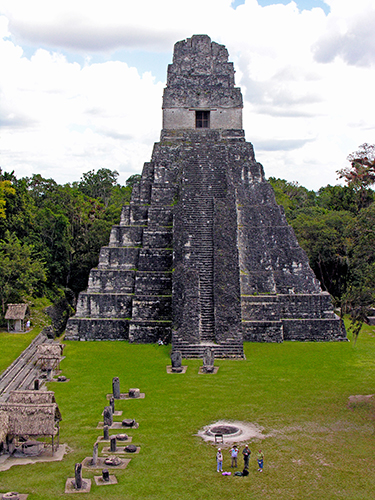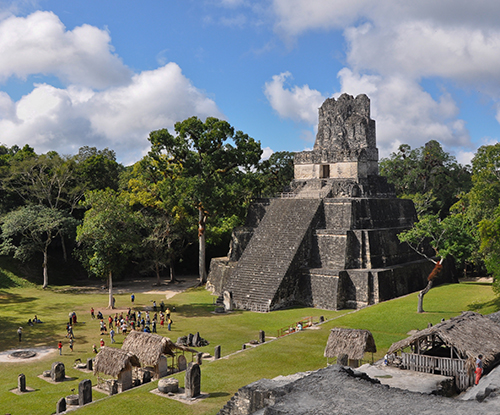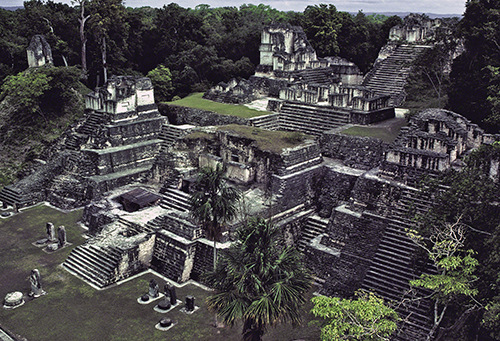Fabulous Tikal
As winter approaches, everyone dreams of vacations again. As an art historian, I have many, many places around the world that I would dearly love to visit, but know that I probably never will. My yearnings include the fabulous Mayan cities in Honduras and Guatemala. (sigh)
The Guatemala Highlands have been the home of the Maya since Preclassic times (ca. 1800 BCE–200 CE). Many cities were at their peak in early Maya civilization, while others reached their apogee in Postclassic times (ca. 900–1300 CE). The city of Tikal flourished during the Classic Period (ca. 250–900 CE). It is located in the jungle of the Petén region, which is thought by ecologists to have once been a savannah (a tropical or subtropical grassland with scattered trees). It was overgrown with jungle after the city was abandoned in Postclassic times. The city thrived for almost a thousand years, the first recorded settlement dating to between 350 and 300 BCE.
At its high point during the Late Classic Period (ca. 600–900 CE), Tikal is thought to have had a population of 50,000 people, and was one of the two largest urban centers in Mesoamerica, along with the great Mexican city Teotihuacán (read more about that city in my post from September). The city prospered based on the trade in such natural resources as cedar wood, brazil wood, copal resin (for incense), flint, and the cultivation of maize.
The art and architecture of Tikal was influenced by Teotihuacán after contact with the Mexican culture (trade or war) in the 370s CE. One of the most magnificent aspects of Tikal is the main plaza that is surrounded by five step pyramids, the result of a building program in the Late Classic Period.
 |
| Maya (Guatemala), Temple I, Tikal, ca. 695–727 CE. Photograph by Dennis Jarvis. CC BY-SA 2.0. (8S-21022) |
After the decline of Teotihuacán in the 500s CE, Tikal, too, suffered from the military expansion of other Mayan cities. Tikal rebounded in the 600s CE, and regained its place as an important Mayan city along with Copán (Honduras) (more about Copán in my post from 2009), Palenque (Mexico) (more about Palenque in my post from 2014), and Calakmul (Guatemala). The Tikal ruler Chan K'awiil (ruled ca. 682–734 CE) defeated Calakmul in 695 CE and instituted thereafter a massive building program to revive the magnificence of Tikal.
The two most impressive results of the building campaign were Temples I and II. Of the five temples on the main plaza of Tikal, Temple I is the tallest at 229 feet (69.7 meters). It is taller than the “Castillo” at Chichén Itzá (Mexico), which was built slightly later and rises to only 24 feet. Both pyramids, however, share the sweeping stairway that rises to the top platform without balustrades or ramps at an angle of 70 degrees. The "temple" is actually the burial place of Chan K'awiil (ruled 682–734 CE). His burial chamber is inside the pyramid's interior, which was found to contain many luxury goods including jaguar pelts, jade objects, and intricately carved scenes on human bones.
Like the pyramids in all Mayan cities, Temple I at Tikal rises in a series of platforms that diminish in size towards the apex. The Guatemalan pyramids still contain their roof comb decoration, which is missing from many Mexican sites.
 |
| Maya (Guatemala), Temple II, Tikal, ca. 682–734 CE. Photo by Mike Vondran. CC BY 2.0. (8S-21023) |
A complementary pyramid was built directly across the main plaza from Temple I, called Temple II. Temple II is thought to have housed the tomb of Chan K'awiil's consort, Lady Tun Kaywak. She is thought to have been from the city of Yaxhá, about 19 miles (30 km) southeast of Tikal. Their marriage cemented a political alliance. Temple II is also called Temple of the Masks because of two that flank the main stairway. The three-step pyramid rises 125 feet (38 meters). Compared to the pyramids of many Mayan cities in Mexico, Guatemalan pyramids tend to be steeper in ascent. Typical of Mayan architecture is the roof comb decoration of both pyramids.
 |
| Maya (Guatemala), North Acropolis, Tikal, ca. 200 BCE–250 CE. Image © 2019 Davis Art Images. (8S-21027) |
Correlations to Davis Programs: A Community Connection 2E 1.5; The Visual Experience 3E 14.4; Discovering Art History 4E 4.9


Comments